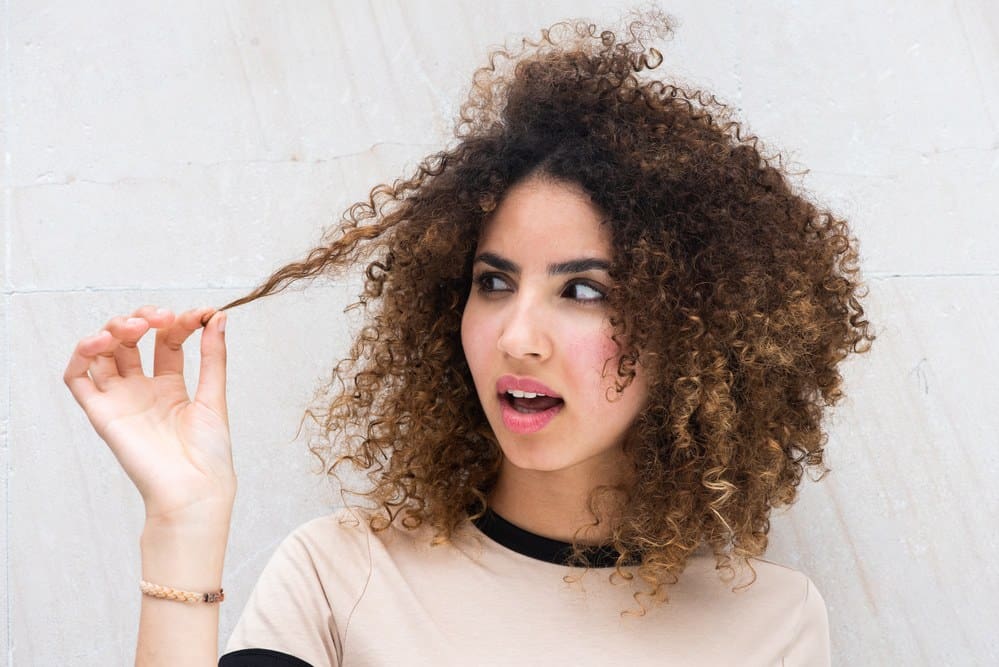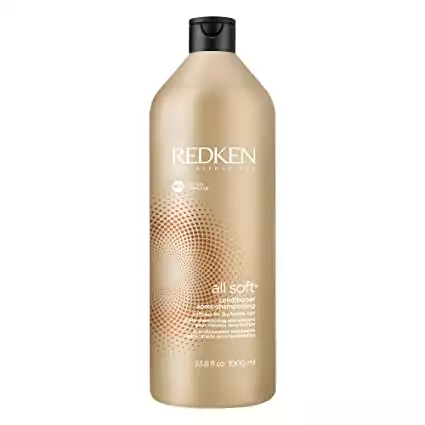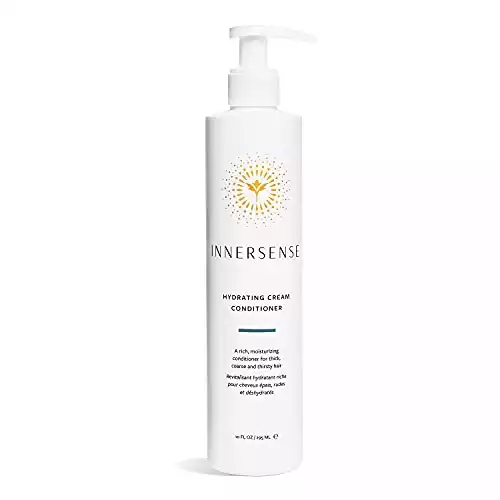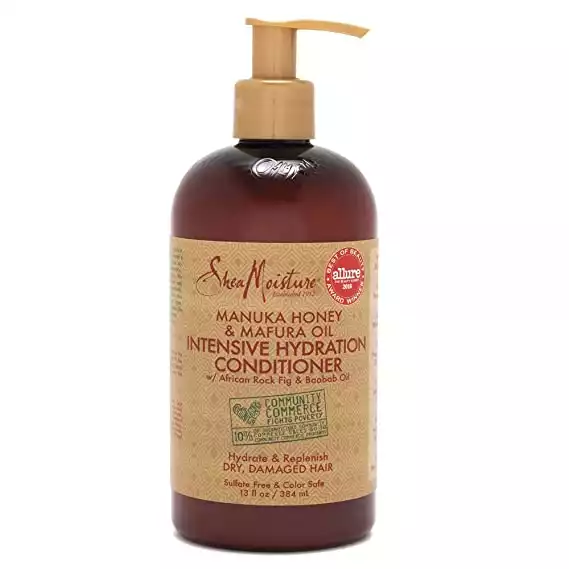
Squish to condish was created by Melissa Stites as a way to incorporate more moisture into your curly hair regimen and mitigate dry, lifeless hair.
As you know, dryness, breakage, and zero absorption are often traits of lifeless hair, and curly hair types are more likely to encounter these issues.
Do you want to nourish your curls? Are you craving those tight ringlets that bounce every time you take a step? We know your pain, and we have a solution to end all others - referred to as the squish to condish method.
Table of Contents
- 1 Squish to Condish: A Quick Guide
- 2 Key Takeaways
- 3 What Is the Squish to Condish Hair Routine?
- 4 How to Properly Squish to Condish
- 4.1 Step 1: Wash Your Hair Using Your Normal Routine
- 4.2 Step 2: Use Hair Conditioner Generously
- 4.3 Step 3: Use a Detangling Comb or Finger Comb to Get Rid of Knots
- 4.4 Step 4: Point Your Head Toward the Floor so Your Hair Goes Back-to-Front
- 4.5 Step 5: Catch Water in Your Hands and Use It to Squish the Water Into Your Hair
- 4.6 Step 6: Repeat Step 5 a Couple of Times
- 5 The Best Conditioners for Squish to Condish
- 6 What to Expect: Before and After Using Squish to Condish
- 7 What Should You Expect After a Squish to Condish Session?
- 8 Super Soaker Method vs. Squish to Condish
- 9 Here’s a Step-by-Step for the Super Soaker Method
- 10 Frequently Asked Questions
- 10.1 What Is the Squish to Condish Method?
- 10.2 Do You Rinse After Squish to Condish?
- 10.3 Why Does Squish to Condish Work?
- 10.4 Is Your Hair Under the Water When You Squish to Condish?
- 10.5 What to Do After Squish to Condish?
- 10.6 How Long Does Squish to Condish Take?
- 10.7 Can You Scrunch Your Hair With Conditioner?
- 10.8 Is Squish to Condish Necessary?
- 10.9 Does Squish to Condish Work for Wavy Hair?
- 10.10 How to Squish Condish Hair in the Back?
- 10.11 How to Dry Hair After Using the Squish to Condish Technique?
- 10.12 Should I Squish to Condish When Using a Deep Treatment?
- 10.13 Related Articles
- 10.14 Final Word
Squish to Condish: A Quick Guide
- Prep & Wash
- Start with your regular hair-washing routine.
- For hydration, use a pre-wash or a gentle sulfate-free shampoo.
- Consider co-washing if you often experience dryness.
- Condition Generously
- Soak your hair with water, then apply conditioner liberally.
- For coily hair types, you might need extra conditioner.
- Consider using silicone-free conditioners.
- Detangle
- Gently remove tangles using a detangling comb or your fingers, working from ends to roots.
- Avoid pulling a brush all the way through your hair; it can damage your hair strands.
- Head Positioning
- Tilt your head forward, making hair roots and ends more accessible.
- For the back of your head, lean closer to the floor or hang over the tub's edge.
- Squish-to-Condish Method
- With hair dripping wet, squish water into your curls, replacing conditioner and boosting moisture.
- Work section by section, focusing on dry areas.
- Repeat for Best Results
- Repeat the squishing process up to three times for optimal hydration.
- Leaving a bit of conditioner in your hair can result in smoother, defined curls.
Key Takeaways
- Curl Types and Hair Care: Different curl types, especially coily hair, might need a generous amount of conditioner during the "squish to condish" method to achieve beautiful curls.
- Squish to Condish Technique: Squish to condish involves washing hair, applying a generous amount of conditioner, detangling, and then squishing water into your hair repeatedly, ensuring every hair strand benefits.
- Wash Day Considerations: For best results on wash day, using a pre-wash or sulfate-free shampoo can make a huge difference, especially if there's a concern about dryness or harsh shampoos.
- Conditioner Usage: Always be generous with conditioner application, focusing on dry spots. Some people prefer leaving some conditioner in their hair for extra moisture.
- Potential Cautions: Avoid the squish-to-condish method on recently color-treated or chemically straightened hair; consult professionals if experiencing hair loss.

What Is the Squish to Condish Hair Routine?
Squish to condish (S2C) uses conditioner as a barrier while pushing water into your hair. The basis of all moisture is water, so it is the best way to hydrate and revitalize your hair.
Many women with curls have trouble getting their hair to absorb water. Since many conditioners smooth your hair cuticle (i.e., often called closing the cuticle), the problem with curly hair is moisture absorption.
Once the hair cuticle has been smoothed down (or lays flat), it is harder to add water and moisture. Since the squish to condish method pushes water into the hair cuticle, it's easier to use water and conditioner to moisturize curly hair.
Note: This method also works great for women with wavy hair.
How to Properly Squish to Condish
Unlock the secret to beautiful curls with the squish to condish method. In this section, we will show you how to care for your curly hair to keep it moisturized and healthy.

Step 1: Wash Your Hair Using Your Normal Routine
Follow your regular hair washing routine. If you start with shampoo, be sure to rinse it thoroughly. Some shampoos raise your hair cuticles and allow you to add more moisture.
If you're worried about your shampoo drying out your hair, try a pre-wash before shampooing or use a gentle sulfate-free shampoo. Pre-wash products protect your hair from damaging ingredients in shampoo.
They also add hydration with thin oils that penetrate as you shampoo.
If you have problems with dryness, try co-washing. Cleansing conditioners work better at keeping in moisture than drying shampoos.
Step 2: Use Hair Conditioner Generously
After soaking your hair with water, do the same with a conditioner. Get every strand, and be generous with the amount that you use. We recommend using a silicone-free conditioner, although you can use the same conditioner you usually use.
If you have a tight curl pattern ("coily hair"), you might need to add more conditioner to your hair as you go on.
Step 3: Use a Detangling Comb or Finger Comb to Get Rid of Knots
Get rid of tangles gently to avoid breakage. Your hair is smoother, but it is also fragile. Detangle from the ends of your hair to the roots. You might also have to detangle after your squish to condish, depending on how your hair reacts.
Never pull a brush all the way through your hair. The strain caused by the brush can be bad for your hair strands.
Step 4: Point Your Head Toward the Floor so Your Hair Goes Back-to-Front
The idea is to make your ends and roots more accessible. Pointing your head towards the floor lets you get to the ends of your hair first, making things easier on your arms. To reach the back of your head, move closer to the floor.
You can also hang your head over the edge of the tub!
Step 5: Catch Water in Your Hands and Use It to Squish the Water Into Your Hair
Here’s where “squish to condish” comes in. You literally squish water into your soaking wet hair. The water replaces the conditioner in your hair, adding moisture and hydration.
Work in sections to get the most benefit. Start at the tips of your hair and work your way up. Focus on dry spots within your curls, especially your ends and the back of your head.
Step 6: Repeat Step 5 a Couple of Times
Do Step 6 to your preference. Some women prefer to leave a bit of conditioner in their hair. That helps trap in the water, resulting in silky smooth hair. We recommend repeating step 5 a maximum of three times.
Note: We don't recommend using this method on recently color-treated hair or hair that's been straightened with a chemical relaxer. Also, if you're experiencing hair loss (or hair fall in certain cultures), consult a medical professional before using this method.

The Best Conditioners for Squish to Condish
Adding conditioners to your hair care routine can sometimes be daunting. You should check the ingredients and find the perfect product for your curl pattern.
We hope to make things easier by telling you which hair products to buy (including styling products) and where to find them online.
Ideally, you want a conditioner that attracts moisture. It will not add buildup to your curly hair, and it will not block water. The conditioner will make it easier to push plain water into your hair.
Humectants attract water to dried-out hair. In humid climates, they are excellent for squish to condish. Be careful in hot, dry climates with no humidity, though! They are just as likely to pull water out of your hair.
If you live in a hot, dry climate, try adding a thicker moisturizer over your hair. Once the humectant attracts water, trap it in your hair with squalene or coconut oil.
These types of oils are known as occlusives. They create a barrier that traps moisture because they are too thick for water to penetrate.
|
Primary Rating:
4.6
|
Primary Rating:
4.6
|
Primary Rating:
4.5
|
|
$52.00
|
$30.00
|
N/A
|
Redken All Soft Conditioner
Redken-All Soft Conditioner is filled with proteins to build your hair from the ground up. Its ingredients focus on restoring hydration. It also has sunscreen to protect the hair and scalp from drying out in the sun.
Pros:
- Contains humectants
- Contains occlusives
- Approved ingredients for curly hair
- Attracts and adds moisture
Cons:
- Small bottle
- Pricey for the size
Innersense Organic Beauty Hydrating Cream Conditioner
This conditioner is made for women with drier, curly hair. The ingredients are focused on adding moisture. The hydrating cream conditioner makes a great co-wash before using the squish to condish technique because of its thin ingredients.
It's also a great conditioner for the Curly Girl Method. Read this article to learn more about the Curly Girl Method.
Pros:
- Certified organic ingredients
- Includes proteins for dull, damaged hair
- Contains humectants
Cons:
- Shea Butter creates buildup over time
- Rice extract should be used sparingly
- Contains fragrance
- High price
SheaMoisture Hydration Conditioner
The honey scent of SheaMoisture Hydration Conditioner leaves your hair smelling amazing. SheaMoisture focuses on damage and rehydration. The cruelty-free brand is an obvious choice with its many curl-friendly options.
Pros:
- Affordable and wallet-friendly
- Ships for free with Amazon Prime
- No sulfates or parabens
- Cruelty-free
Cons:
- Some cleansing ingredients*
*Squish to condish combats cleansing ingredients because you do not wash the conditioner completely out of your hair.
What to Expect: Before and After Using Squish to Condish
While squish to condish is easy, there is a specific end result. Your curls should look tighter and fall together beautifully. In the end, you want hydrated and bouncy curls.
Unhealthy strands look dull, and they do not move easily. Let it go too far, and you get breakage. Focus on repairing damage, adding moisture, and fighting against those dead ends.
Hydrated hair stretches and moves. You can tell because it looks happier and shinier. It grows healthily and looks amazing. Because your hair absorbs water more easily, you will see a difference almost immediately.

What Should You Expect After a Squish to Condish Session?
First of all, your curls will be happy! They usually clump together (i.e., often called curl clumps) and look hydrated. Any signs of dryness should be gone. There should be no frizz or dullness.
It will be much easier to style your hair. Because your hair is stretchier due to moisture, it is one-thousand times easier to move it around.
Special Note: Do not rinse your hair after using the squish to condish conditioning method. It weighs down your curls and releases some of the moisture. You will want to use a small bit of conditioner to help keep the water and conditioner within your hair strands.

Super Soaker Method vs. Squish to Condish
The super soaker method is similar to squish to condish. Both are meant to hydrate the hair as much as possible. The most significant difference between the two is in the products that you use.
Squish to condish uses conditioner. By pressing water into the hair, you replace the conditioner and achieve maximum hydration.
The super soaker method uses leave-in products like gels, essential oils, and leave-in conditioners. Instead of replacing your conditioner with water, you replace water with your leave-in products.

Here’s a Step-by-Step for the Super Soaker Method
Learn the Super Soaker Method for defined curls. This technique is essential for curly hair. This section offers a step-by-step breakdown to guide you through this hydrating process. This guide explains everything, whether you're new or trying to become an expert.
Step 1: Complete Your Normal Wash Routine
That includes soaking your hair, flipping your head upside down, and squishing water into your hair. Once you replace the conditioner on your head with water, the steps get a bit more unique.
Step 2: Apply Your Leave-in Products and Scrunch Your Hair
Here’s the unique part! Push the leave-in products into your hair. By replacing the water in your hair, you add key moisturizers directly to your hair follicles.

Frequently Asked Questions
Got questions? You're not alone! Dive into our FAQ section below to find detailed answers to some of the most commonly asked questions about the squish-to-condish technique.
What Is the Squish to Condish Method?
The squish-to-condish method is a hair conditioning technique primarily used for curly hair. It involves applying conditioner, then adding water and using a "squishing" motion to help the hair absorb the conditioner, enhancing curl definition and hydration.
Do You Rinse After Squish to Condish?
Yes, after applying and squishing the conditioner into the hair using the squish-to-condish method, you should rinse out the excess conditioner, typically with cool water, to seal the hair cuticle and lock moisture into the hair shaft.
Why Does Squish to Condish Work?
According to the Science-y Hair Blog, there is some scientific background to this method! In their words, a traditional condition-and-rinse is not as effective. The conditioner does not cover the hair as much, meaning there is no moisture absorption.
Squish to condish covers nearly every part of the hair follicle. It retains moisture more easily, making the hair less likely to dry out. By covering every part of the hair with conditioner and water, you get the maximum results for better hydration.
Is Your Hair Under the Water When You Squish to Condish?
No, you should not rinse your hair or leave it under the water. The point of squish to condish is to press water into your hair. Use the palms of your hands and fill them with water.
If you have trouble getting to the back of your head, try leaning your head as far as possible. Once you finish, try to avoid running water through your hair. The whole point is to scrunch up those curls!
What to Do After Squish to Condish?
After the squish-to-condish method, gently remove excess water from your hair, apply any leave-in products or stylers as desired, and then allow your hair to air dry or use a diffuser for added volume and definition.
How Long Does Squish to Condish Take?
The squish-to-condish method typically takes between 5 to 10 minutes, depending on hair length and thickness. It involves the time to apply conditioner, squish with water, and then rinse.
Can You Scrunch Your Hair With Conditioner?
Yes, you can scrunch your hair with conditioner. Scrunching while the conditioner is in the hair can help enhance natural curl or wave patterns, improving definition.
Is Squish to Condish Necessary?
Squish to Condish is not necessary for everyone, but it can benefit those with curly or wavy hair looking to enhance curl definition and maximize hydration.
Does Squish to Condish Work for Wavy Hair?
Yes, the squish to condish method can work for wavy hair. It can help to enhance the natural wave pattern, reduce frizz, and provide better moisture retention.
How to Squish Condish Hair in the Back?
Way too often, we neglect the backs of our heads. It is harder to reach, and sometimes the overall texture is different. It gets even more challenging with shorter hair.
Because your head is upside down, getting to the hair in the back is tough. There are a few ways to reach the back of your head, though!
Putting your head horizontally to the floor is the simplest method. Longer hair is also easier to work with this way. Start nearly upright to reach your ends. As you work your way to the back of your head, tilt your head further down.
Shorter hair needs a bit of extra work. Try hovering backward over a sink because you have less hair to work with; you only have to stay in the position for a few seconds.
How to Dry Hair After Using the Squish to Condish Technique?
There are plenty of ways to dry curly hair after a nice shower! It really depends on the dryness and overall texture (or curl pattern) of your hair. Because you want to keep the conditioner and moisture in your hair, try the most gentle methods.
Air drying is the simplest way to dry your hair. For people with thicker hair, it can take a while for your hair to air dry. If you have shorter hair that dries easily, air drying is the way to go. Just apply your favorite leave-in products and let your hair sit.
Diffusing is a great way to enhance your curls. If you have a diffuser attachment for your blow dryer, feel free to use it! This is an excellent alternative for women with slow-drying hair. Remember, diffusing your hair upside down is way more effective than doing it upright.
The best way to dry hair after squish to condish is plopping. Wrapping your hair helps your hair dry quickly. Be sure to use the right material. Using cotton or traditional towels, overdry your hair and sap the moisture right out of it. Use microfiber towels, or use a T-shirt.
Should I Squish to Condish When Using a Deep Treatment?
Using a deep conditioner to squish to condish works, as it's an effective way to penetrate your hair follicles.
In general, a deep conditioner is meant to penetrate the hair, and it does not need much help. You can go the extra step by squishing water into your hair after deep conditioning. Water plus deep conditioner usually results in outstandingly hydrated hair.
- How To Take Care of Wavy Hair
- Curly Girl Method Steps
- What Is Low Poo Method?
- How Many Times Should You Moisturize Your Hair
Final Word
The squish to condish method is a new way of conditioning your hair that creates hydration and moisture. It may be difficult for some curly girls to keep their hair moisturized, but with the help of this technique, you can get great results. Give it a try and see how much better your curls look!







